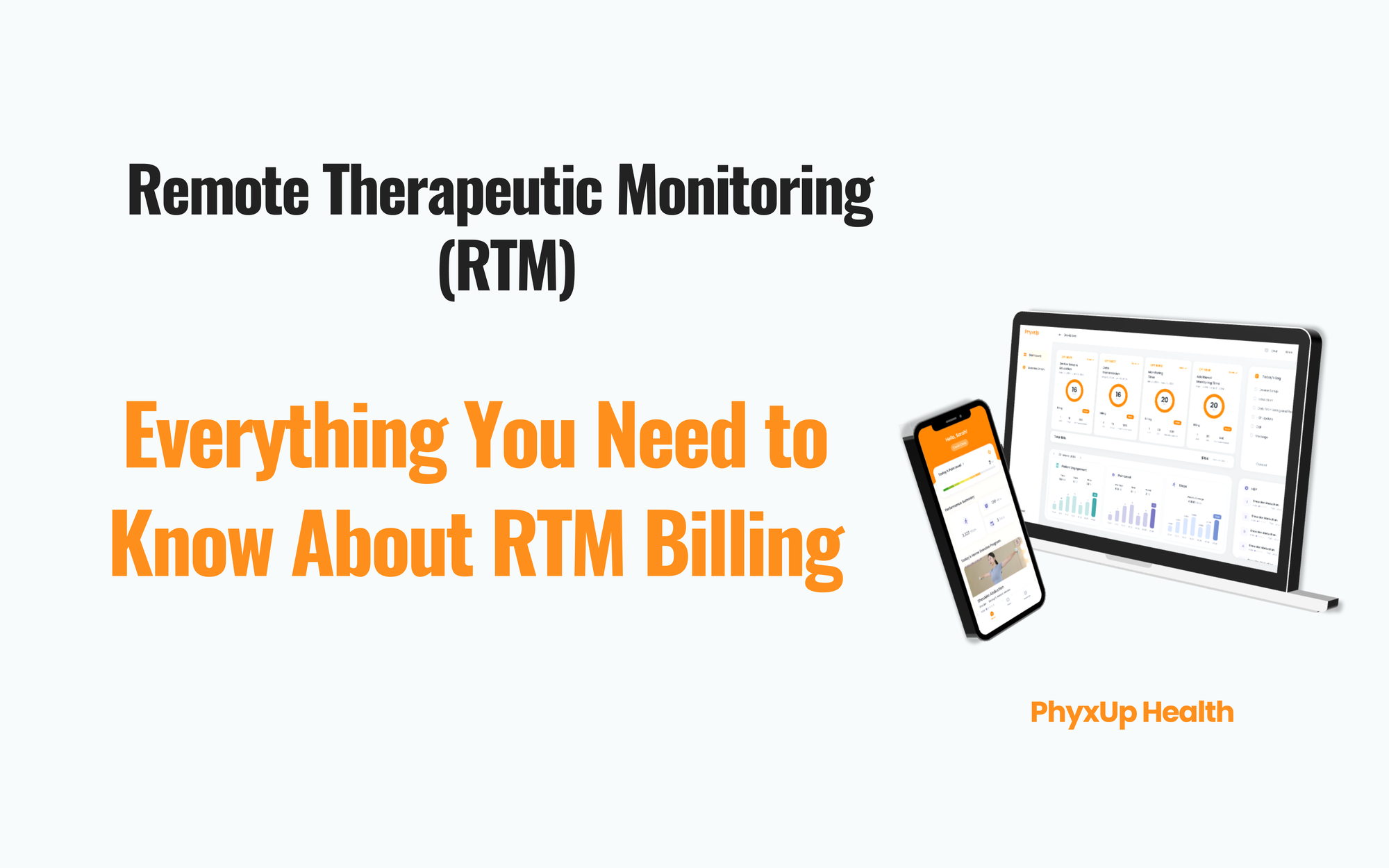The Ultimate Guide to CPT Codes for Remote Therapeutic Monitoring (RTM)

Remote Therapeutic Monitoring (RTM) has quickly become a game-changer for musculoskeletal (MSK) care. By using mobile apps to track patient progress outside the clinic, providers improve outcomes and create new revenue opportunities. But if you’re not billing correctly, you might leave money on the table.
In this guide, we’ll break down the four most important CPT codes for RTM—98975, 98977, 98980, and 98981—so you can understand what each one covers, when to bill, and how to document properly. Whether you’re new to RTM or looking to improve your workflow, this article will help you make sense of it all.
What Is RTM and Why Does It Matter?
The benefit? Providers can catch issues early, make adjustments in real time, and keep patients on track—all while generating additional income. CMS has approved six CPT codes for RTM, but four are particularly relevant for MSK care.
With the healthcare industry shifting toward value-based care, tools like RTM empower providers to stay connected with patients without requiring more in-person visits. It’s about extending care beyond the clinic and proving outcomes with data. For providers who are already stretched thin, RTM offers a scalable, efficient solution.
What is Remote Therapeutic Monitoring (RTM)?
CPT Code 98975: Initial Setup and Patient Education
Think of 98975 as your RTM launchpad. This code covers the work done to get the patient started with RTM:
- Setting up the RTM app or device
- Educating the patient on how to use it
- Getting informed consent
Who can bill it? Physicians, physical therapists, occupational therapists, speech-language pathologists, and other qualified healthcare professionals.
Billing tips:
- Can be billed once per episode of care.
- Requires 16 days of patient engagement within a 30-day period.
Documentation checklist:
- Device/platform used
- Patient education summary
- Instructions provided to the patient or caregiver
CPT Code 98977: RTM Device/App Supply
This code is for when a provider supplies the technology, such as an app, that allows a patient to send their health data remotely. It’s not just about giving them the tool, but about enabling continuous data transmission. That data (like pain levels, exercise logs, or activity compliance) is then shared with the provider so they can monitor progress and make informed decisions, even between visits.
What does it cover?
- Supplying the patient with an RTM device or app
- Ensuring the system records and shares data like pain scores, activity levels, and HEP compliance
Who can bill it? Same as 98975—physicians, PTs, OTs, and more.
Billing tips:
- Can be billed once every 30 days.
- At least 16 days of patient data must be collected during the 30 days.
Documentation checklist:
- Device or software name
- Data transmission logs
- Patient activity records
CPT Code 98980: First 20 Minutes of Treatment Management
Now that your patient is set up and transmitting data, you need to manage their care. CPT 98980 covers your time spent doing exactly that.
What’s included?
- Reviewing patient-generated data
- Adjusting the treatment plan based on that data
- One interactive communication (phone or video) during the month
Who can bill it? Physicians, PTs, OTs, and other qualified providers.
Billing tips:
- Billable once per calendar month for the first 20 minutes.
- Requires documentation of interactive communication and clinical decision-making.
Documentation checklist:
- Time logs
- Type of communication (e.g., phone, video)
- Summary of clinical decisions or plan changes
CPT Code 98981: Additional 20 Minutes of Treatment Management
Patients with complex needs may require more time. That’s where CPT 98981 comes in—it covers each additional 20-minute block of RTM treatment management.
What’s included? Same activities as 98980:
- Data review
- Communication with the patient
- Updates to the plan of care
Billing tips:
- Billable in 20-minute increments beyond the first 20 minutes covered by 98980.
- No monthly cap, but each billed unit must meet the time and documentation requirements.
Documentation checklist:
- Additional time logs
- Patient communication details
- Adjustments made based on ongoing data
Summary Table
| CPT Code | Description | Billing Frequency | Requirements |
|---|---|---|---|
| 98975 | Initial RTM setup + patient education | Once per episode | 16 days of use in 30 days |
| 98977 | RTM device/app supply | Once every 30 days | 16 days of data transmission |
| 98980 | First 20 mins of treatment management | Once per calendar month | ≥ 20 mins + 1 interactive communication |
| 98981 | Each additional 20 mins of treatment management | Multiple times per month | Each block requires 20 mins + documentation |
Why This Matters for Your Practice
Using RTM the right way not only supports better patient outcomes—it opens a new revenue stream that rewards you for time you’re likely already spending.
Practices that integrate RTM effectively are also seeing improved patient satisfaction. Patients feel more supported knowing their therapist is checking in—even when they’re not physically present. This consistent connection helps build trust and improves adherence to home programs.
RTM can also set your clinic apart from competitors. As patients become more tech-savvy, they’re expecting digital support between visits. Offering RTM shows that your clinic is modern, responsive, and truly patient-centered.
And with platforms like PhyxUp Health, tracking, documenting, and billing for RTM becomes seamless. The app automates data capture, generates real-time dashboards, and even handles billing, so providers can focus more on patient care.
So don’t leave value on the table. Learn the codes. Use them wisely. And deliver care that goes beyond the clinic walls.
Want help implementing RTM? PhyxUp Health is designed to simplify RTM for providers. From initial setup to billing support, we make it easy to stay compliant while providing excellent care.
👉 Visit phyxuphealth.com to learn more.
